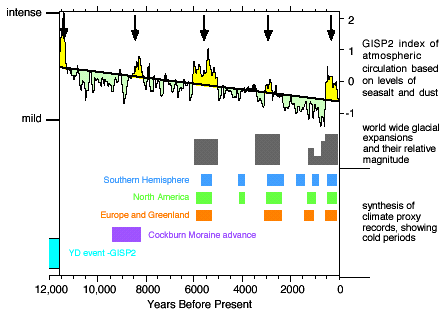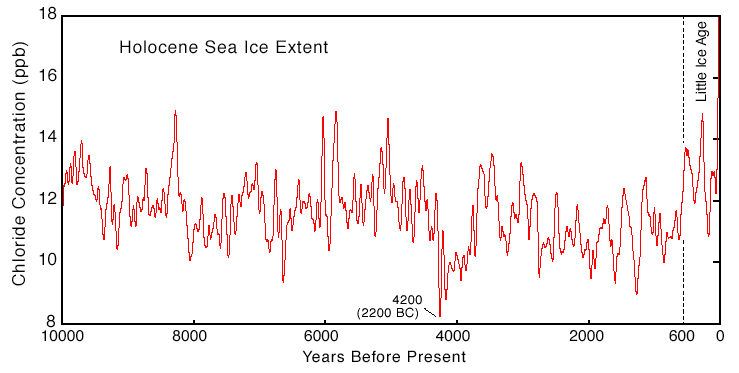Dramatic natural changes in climate have seriously affected humans
and ecosystems and have occurred in less than a human lifetime.
Near-1500 year cycles approximated by a bandpass component from the original series (99.9% significant) of abrupt climate change pace climate during the last 10,000-70,000 years. In addition to the dramatic changes in the strength of polar atmospheric circulation (PCI) noted above, massive changes in temperature, accumulation rate, and the greenhouse gas methane characterize these events. Although the cause(s) for these abrupt changes in atmospheric circulation is not fully understood they may be caused by changes in the energy output of the Sun, and/or changes in the internal rhythms of the ocean-atmosphere system.

The Holocene (the last 11,500 years) is characterized by significant change in climate. The Greenland Ice Core (GISP2) contains a record of annually resolved sea-salt and dust deposition that indicates a quasi-2600 year cycle (OBrien et al., 1995), consistent with world wide glacial expansions (Denton and Karlen, 1973). Proxy records of cold conditions, including the Younger Dryas (YD) and the Cockburn glacial advance, exist for Europe, Greenland, North America, and the Southern Hemisphere (Harvey, 1980; Andrews and Ives, 1972; Alley et al., 1997; Stager and Mayewski, 1997; Alley et al., 1993; Mayewski et al., 1993). Note the abrupt onset of intensified atmospheric circulation and cooling close to 1400 AD.

The Holocene (the last 11,500 years) is characterized by significant change in climate. The Greenland Ice Core (GISP2) contains a record of annually resolved sea-salt and dust deposition that indicates a quasi-2600 year cycle (O'Brien et al., 1995), consistent with world wide glacial expansions (Denton and Karlen, 1973). Proxy records of cold conditions, including the Younger Dryas (YD) and the Cockburn glacial advance, exist for Europe, Greenland, North America, and the Southern Hemisphere (Harvey, 1980; Andrews and Ives, 1972; Alley et al., 1997; Stager and Mayewski, 1997; Alley et al., 1993; Mayewski et al., 1993). Note the abrupt onset of intensified atmospheric circulation and cooling close to 1400 AD.
Change in sea ice extent in the North Atlantic over the last 10,000 years as determined from measurements of chloride in the GISP2 ice core. Chloride is transported as NaCl (sea salt) from the ocean to the GISP2 site. Increased levels characterize the Little Ice Age (note rise in chloride as of AD 1400), a period with relatively greater storminess over the ocean and land plus more sea ice than during much of the Holocene. Conversely, decreased values are characteristic of periods with less sea ice and more summer-like conditions over the North Atlantic. The period around 2200BC shows the most dramatic decrease in chloride in the record and hence more summer like conditions over the North Atlantic. Around 2200 BC much of modern day Syria and possibly regions as far away as eastern China experienced drought like conditions. Syria is characterized by a summer dry period and a winter wet period. Increase in summer-like conditions could have heralded conditions conducive to a longer dry season during the 2200BC collapse period contributing to one of the more dramatic disruptions in ancient civilization, the collapse of the Akkadian Empire.

Interestingly, extremes in the GISP2 chloride record (interpreted as changes in sea ice extent in the North Atlantic) appear to coincide with at least two major events in the Holocene that had dramatic consequences on the course of civilization. These were the Little Ice Age and the collapse of the Akkadian Empire (2200 BC). While small compared to glacial period (11,500-110,000 years ago) rapid climate change events, Holocene climate change events appear to have been sufficiently large to affect humans.
Selected References:
Denton, G.H. and Karlen, W., 1973, Holocene climatic variations - Their pattern and possible cause, Quaternary Research, 3, 155-205.
Mayewski, P.A., Buckland, P.C., Edwards, K.J., Meeker, L.D., O'Brien, S.O. and Buckland, P., 1996, Climate change events as seen in the Greenland ice core (GISP2): Implications for the Mesolithic of Scotland, The Early Prehistory of Scotland, Edinburgh University Press, Scotland, 74-83.
Mayewski, P.A., Meeker, L.D., Twickler, M.S., Whitlow, S.I., Yang, Q., Lyons,W.B. and Prentice, M., 1997, Major features and forcing of high latitude northern hemisphere atmospheric circulation over the last 110,000 years, Journal of Geophysical Research, 102, C12, 26,345-26,366.
O'Brien, S.R., Mayewski, P.A., Meeker, L.D., Meese, D.A., Twickler, M.S. and Whitlow, S.I., 1996, Complexity of Holocene climate as reconstructed from a Greenland ice core, Science, 270, 1962-1964.

